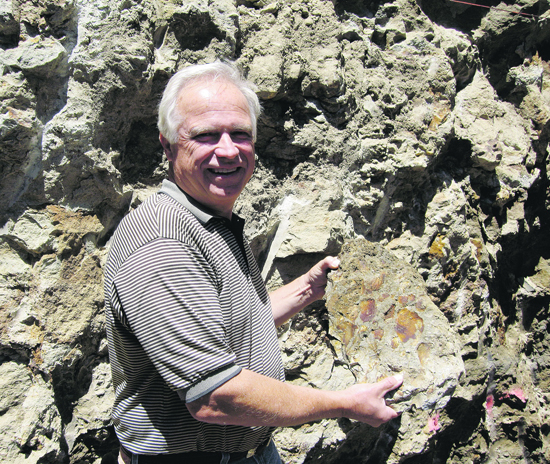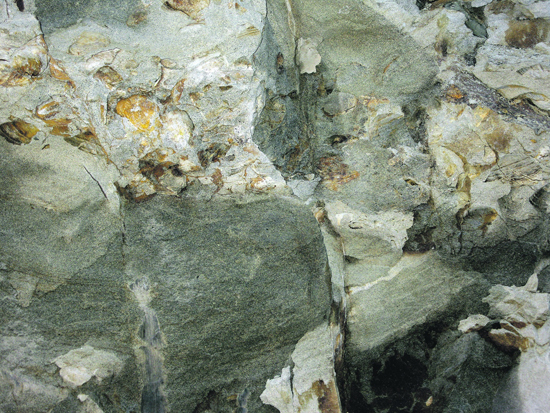 | | | Dave Rey holding stone embedded with marine fossils. Photo Brett Scheiner
| | | | | | It's a warm day in Lafayette, the temperature is pushing 90 degrees, and Dave Rey stands next to a huge, gaping hole alongside his driveway about five car lengths from his front door. The 20-foot-deep hole is the opening for Rey's wine cave-what will eventually be a 1,000 square foot barrel room for storing and aging the wines produced by the Rey family's Reliez Valley Vineyards. "There are a lot of variables to control for," says Rey, but if all goes according to plan, the subterranean space will keep his wine in a cool 55-degree environment without the need for additional refrigeration and provide a fun space for family and friends to do some wine tasting too.
 Excavation for the 30 by 20 foot room was originally estimated to take about two weeks, but about six feet into "the dig" the soil turned to rock and the process slowed significantly. As Brett Scheiner pounded through the hard earth using a hydraulic hoe ram attached to a Caterpillar excavator, he and Rey made a remarkable discovery. A couple of 12-inch veins of fossil-rich sandstone, a bed of marine fossils, traversed the walls of the cave. While fossil findings are not an everyday occurrence for Rey, a former management consultant, he was not totally surprised. When Rey planted his first 500 cabernet and malbec grapevines six years ago, he unearthed several large boulders in the vineyard that had fossilized shell fragments scattered throughout. He set the large rocks at the end of the rows of vines and did not think too much about it then. In contrast, the sandstone chunks pulled out in June while excavating the wine cave have hundreds of fossils which are intact, clam-shaped shells with semi-circular ridges.
Excavation for the 30 by 20 foot room was originally estimated to take about two weeks, but about six feet into "the dig" the soil turned to rock and the process slowed significantly. As Brett Scheiner pounded through the hard earth using a hydraulic hoe ram attached to a Caterpillar excavator, he and Rey made a remarkable discovery. A couple of 12-inch veins of fossil-rich sandstone, a bed of marine fossils, traversed the walls of the cave. While fossil findings are not an everyday occurrence for Rey, a former management consultant, he was not totally surprised. When Rey planted his first 500 cabernet and malbec grapevines six years ago, he unearthed several large boulders in the vineyard that had fossilized shell fragments scattered throughout. He set the large rocks at the end of the rows of vines and did not think too much about it then. In contrast, the sandstone chunks pulled out in June while excavating the wine cave have hundreds of fossils which are intact, clam-shaped shells with semi-circular ridges.
 So was Rey's residence once beachfront property? The question is difficult to answer without the input of some expert geologists. And by fortuitous coincidence, Rey happened to be working with a couple of geologists to collect data on the nature of the soil and topography of the Lamorinda area who could help answer the question.
So was Rey's residence once beachfront property? The question is difficult to answer without the input of some expert geologists. And by fortuitous coincidence, Rey happened to be working with a couple of geologists to collect data on the nature of the soil and topography of the Lamorinda area who could help answer the question.
 As a member of the Lamorinda Winegrowers Association (LWGA), Rey is coordinating the group's effort for Lamorinda to be designated as an American Vitcultural Area (AVA), or a distinct winegrowing region also known as an appellation. The AVA is essentially the geographic pedigree of an area's wine. A Lamorinda-specific appellation has been a goal of the winegrowers' organization since its inception, but it's a complex, multi-faceted process that will likely take a few years to achieve. The LWGA has to demonstrate that this area has a microclimate, soil, and topography that are unique and distinctive. While not part of the original plan, Rey's dig will likely provide data regarding the nature of the soil and topography of the area for the application.
As a member of the Lamorinda Winegrowers Association (LWGA), Rey is coordinating the group's effort for Lamorinda to be designated as an American Vitcultural Area (AVA), or a distinct winegrowing region also known as an appellation. The AVA is essentially the geographic pedigree of an area's wine. A Lamorinda-specific appellation has been a goal of the winegrowers' organization since its inception, but it's a complex, multi-faceted process that will likely take a few years to achieve. The LWGA has to demonstrate that this area has a microclimate, soil, and topography that are unique and distinctive. While not part of the original plan, Rey's dig will likely provide data regarding the nature of the soil and topography of the area for the application.
 Not long after Rey made his fossil discovery, Mike Oskin, an Associate Professor of Geology at the University of California Davis who has been consulting with the LWGA on the AVA application, spent a day with Rey driving around Lamorinda exploring exposed rock and soil. In Rey's wine cave dig, Oskin found the shallow marine sandstone to be consistent with the published geological maps for the Lamorinda area, which dates the fossils to six to 10 million years ago in the late Miocene period. "Sedimentary rocks of that age are not all that uncommon in this area if you know where to find them," says Oskin, but he admits the wine cave dig presented a good opportunity to observe Lamorinda's underground. Today, Rey's property lies between 600 and 660 feet above sea level, and Oskin acknowledges that these findings support the fact that the area was once under water.
Not long after Rey made his fossil discovery, Mike Oskin, an Associate Professor of Geology at the University of California Davis who has been consulting with the LWGA on the AVA application, spent a day with Rey driving around Lamorinda exploring exposed rock and soil. In Rey's wine cave dig, Oskin found the shallow marine sandstone to be consistent with the published geological maps for the Lamorinda area, which dates the fossils to six to 10 million years ago in the late Miocene period. "Sedimentary rocks of that age are not all that uncommon in this area if you know where to find them," says Oskin, but he admits the wine cave dig presented a good opportunity to observe Lamorinda's underground. Today, Rey's property lies between 600 and 660 feet above sea level, and Oskin acknowledges that these findings support the fact that the area was once under water.
 After a total of 6weeks the wine excavation is finally complete, but Rey is not frustrated by the delay posed by the fossil-rich rock. "The lime-rich marine fossils combined with sandstone is a good combination for growing grapevines," says Rey. "It's a positive attribution to the terroir (growing environment) of my vineyard."
After a total of 6weeks the wine excavation is finally complete, but Rey is not frustrated by the delay posed by the fossil-rich rock. "The lime-rich marine fossils combined with sandstone is a good combination for growing grapevines," says Rey. "It's a positive attribution to the terroir (growing environment) of my vineyard."

|

